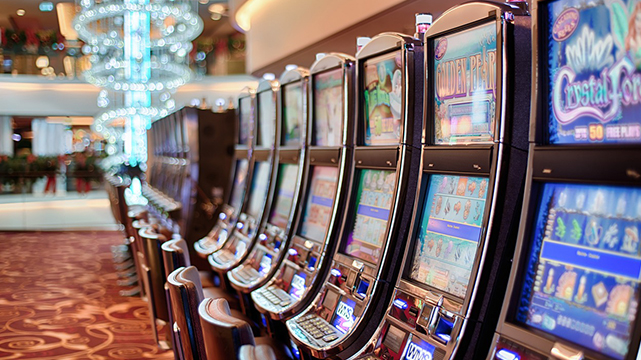Everyone who gambles on slots wants to know where the loosest slot machines are. After all, those are the slots that offer you the best chance of winning, right?
In this post, I provide some insights into how to find the loosest slot machines.
The Differences between Loose and Tight Slot Machines
A tight slot machine is one that keeps a high percentage of your money and doesn’t pay out a lot of money.
A loose slot machine, on the other hand, is one that keeps a relatively small percentage of your money and pays out a lot in winnings.
The idea behind learning how to find the loosest slot machines is that you’ll be more likely to win when playing these games at the casino. You’ll have an edge over the rest of the schmucks who are playing the tight slot machines.
I’d like to point out that ALL slot machines have a mathematical edge for the house – loose or tight. So, if you play the slot machines long enough, you’re guaranteed to lose all your money.
It’s like investing your money into stocks that are constantly losing share value year over year. It’s a losing game.
Whether the stock loses 5% every year or 10% every year doesn’t matter.
You can find something better to do with your money.
Payback Percentages and Hit Frequencies with Slot Machines
One way to think about how loose a slot machine is to think about how high the payback percentage for the game is. This is a legitimate way of thinking about the subject, too.
The payback percentage is a statistical estimate of how much of each bet the casino is going to pay back to its players in winnings. It’s always a number below 100% – the casino’s always going to generate a profit in the long run.
For example, if you’re playing real money slot machine games with a 95% payback percentage, in the long run, you’ll lose 5% of every bet you make. The curve won’t be smooth, though – you’ll see winning sessions and losing sessions, and your bankroll will go up and down.
But, eventually, if you play long enough, the curve will trend downward no matter how jagged it is.
Also, payback percentage is a long-term phenomenon based on the payouts and the probabilities of getting those payouts. The games are still random. In the short term, you can still get lucky and win – even on a so-called “tight” slot machine.
The other aspect of slot machine’s paybacks that a lot of gamblers consider is “hit frequency.” This is how often you get a winning result. One slot machine game might have a hit frequency of 20%, which means you’ll see a winning spin once every 5 spins or so.
Another slot machine game might have a hit frequency of 40%. This means you’ll see a winning spin twice every 5 spins or so.
You can play a slot machine with a low hit frequency that still has a high payback percentage, and you can also play a slot machine with a high hit frequency that has a low payback percentage.
The difference has to do with the size of the prizes. If the top prize is huge but almost impossible to hit, the game might have a high payback percentage, but the hit frequency might be really low.
It’s up to you to decide which aspect is more important when you’re thinking about how loose or tight a slot machine game is.
High Denomination Slot Machines
Casinos and slot machine manufacturers don’t generally label their games with payback percentage numbers, so it’s impossible to say with any certainty which games have higher payback percentages than others.
But we can make some generalizations based on public information.
In many states, casinos are required to report payback percentages to the public. Such reports are often categorized according to the stakes being played for.
A common repot for Nevada slot machines will list payback percentages based on the following categories:
- Penny slots
- Quarter slots
- Dollar slots
- All slots
In Lake Tahoe, for example, penny slots have a payback percentage of 89%, while quarter slots have a payback percentage of 91%.
Dollar slots are even better, with a payback percentage of 93%.
This holds true just about everywhere I’ve read reports. The higher the denomination is, the higher the payback percentage is.
So, if you’re looking for the loosest slot machines, look for the games with the highest denominations.
The Effect of Denomination on Hourly Loss Rates
This doesn’t mean you’re not going to lose money. Let’s look at how much money you’re expected to lose per hour at these different denominations and payback percentages.
If you’re playing penny slots, you’re probably spending at least 50 cents per spin. The penny games require you to bet a specific number of pennies on a specific number of lines.
At 50 cents per spin, you’re looking at wagering $250 per hour – assuming you make 500 spins per hour.
With a payback percentage of 89%, you’re expected to lose $27.50 per hour. That’s expensive entertainment.
Let’s say you’re playing the dollar machines, which have a payback percentage of 93%.
If you’re playing for 3 credits per spin, you’re putting $1500 into action per hour. Your expected loss on that action is $105.
Even though you’re playing the “looser” machines, you’re still going to lose more money in the long run than you would playing at the lower stakes.
Flat Top Slot Machines versus Progressive Slot Machines
A flat top slot machine is a game with a fixed jackpot. 1000 coins is a common top prize on a flat top slot machine game, although it varies from game to game.
A progressive slot machine, on the other hand, is a game where the size of your jackpot grows as you (and sometimes other players) keep betting. Such jackpots can approach life-changing status. Megabucks, for example, has a top jackpot that starts at $10 million.
Which kind of slot machine game is looser?
Here’s what you need to understand about progressive slot machines:
First, a tiny percentage of each bet is allocated to fuel that progressive jackpot. That percentage comes straight out of your payback percentage. Obviously, the machine can’t put money toward the jackpot and toward your winnings at the same time.
Second, the jackpot is a longshot – a big-time longshot. The probability of hitting Megabucks is so low that you could play for 40 hours a week for 50 years and still never hit the jackpot.
Third, even if the payback percentage for a progressive slot machine is relatively high, a chunk of that comes from the jackpot – which you’re extremely unlikely to ever hit. So, the effective payback percentage for the game is significantly lower than the numbers would have you believe.
Online Slot Machine Games
You’ll find plenty of websites quoting payback percentages for various casinos’ slot machine games. I spoke with someone in the industry one time who asked me, “Do you know where the website operators got those numbers?”
I told him no.
He replied, “Me neither. I know I didn’t supply any payback percentage numbers to my affiliates.”
My point is that you can’t believe the payback percentage numbers posted on affiliate websites. An affiliate website is one where the gambling information portal owner gets a percentage back from the casino in exchange for referring the player.
Many of these affiliates have high degrees of integrity. They work hard to screen casinos by reputation and only offer a quality product to their users. This doesn’t mean you can rely on their reports or tables comparing payback percentages.
Usually, the differences between one casino and another casino on such a table is minimal anyway.
Keep some records of how much you’ve gambled on a game and how much you’ve won or lost.
Your results won’t have much statistical validity at first, but if you keep careful records, you can begin to get an idea of which slot machine games at which online casinos really are looser than others.
The formula is simple, too. Track how many spins you make. Multiply that by the amount you’re wagering per spin.
That’s how much money you put into action that hour.
Then look at the difference between how much you started your session with and how much you finished with.
If you put $1500 into action and lost $150, the payback percentage for that game during that session was 90%.
It takes thousands of spins to get confident that your numbers reflect actual probabilities, but your numbers from doing these calculations will still be more accurate than the numbers you’ll find on some random website.
Conclusion
How can you find the loosest slot machines?
The best and easiest way is to find a site like American Casino Guide that offers reports on the payback percentages in various locations and at various denominations.
This is only of limited use, though, because the information applies to the casinos overall rather than to specific machines inside the casino.
But if you stick with the flat top slot machine games in the casinos with the highest payback percentages, you’ll have a better shot at finding the loosest slot machines.
The post How to Find the Loosest Slot Machines appeared first on GamblingSites.ORG.



